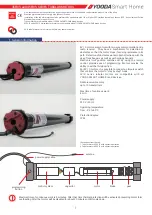
10
– English
EN
This product constitutes an integral part of the automation system, therefore it must
be disposed of along with it.
As in installation, also at the end of product lifetime, the disassembly and scrapping oper-
ations must be performed by qualified personnel.
This product is made up of different types of material, some of which can be recycled while
others must be disposed of. Seek information on the recycling and disposal systems
envisaged by the local regulations in your area for this product category.
Caution!
– some parts of the product may contain pollutant or hazardous substances
which, if disposed of into the environment, may cause serious damage to the environment
or physical health.
As indicated by the symbol on the left, disposal of this product in domestic
waste is strictly prohibited. Separate the waste into categories for disposal,
according to the methods envisaged by current legislation in your area, or
return the product to the retailer when purchasing a new version.
Caution!
– Local legislation may envisage serious fines in the event of abusive
disposal of this product.
❏
When the motor is switched on, no beep is emitted and the Step-by-Step
input does not command any movement.
Make sure the motor is powered at the correct mains voltage; if the power supply is cor-
rect there is probably a serious fault and the motor needs to be repaired by the customer
service department.
❏
The motor does not move after a command is given.
• If it has been working up until then, it may be that the thermal protection device has cut-
in, therefore wait a few minutes for the motor to cool.
• Check if the “Step-by-Step” input is functioning by joining the White and Black/White
wires together for a second.
• Make sure that there is at least one memorized transmitter, checking that the motor
emits short beeps when switched on.
• Make sure that the transmitter and motor are communicating, keeping button
■
(2) of a
transmitter (memorized or not) pushed for at least 5 seconds, if a beep is heard this
means that the motor is receiving the signal from the transmitter therefore go on to the
last control; otherwise perform the next control.
• Check the correct emission of the transmitter radio signals with the following empirical
test: push a button and rest the LED against the aerial of a normal household radio (ide-
7
What to do if...
a short troubleshooting guide!
6
Disposal of the product
ally inexpensive) that is switched on and tuned in at 108.5 Mhz FM or as close as possi-
ble; a low sound should be heard with crackling pulses.
• Check, by slowly pushing one at a time, all of the transmitter buttons, if none of them
command a movement of the motor, this means that the transmitter is not memorized.
❏
After a radio command, 6 beeps are heard and the manoeuvre does not
start.
The radio control unit is unsynchronised, repeat the transmitter memorization process.
❏
After a command, 10 Beeps sound and then the manoeuvre begins.
The auto-diagnosis of the memorized parameters has revealed a fault (positions, TTBUS
address, wind levels are incorrect). Delete and repeat programming if necessary.
❏
When raising the motor stops before reaching the set position (pos. “0”,
pos. “I”) and then makes three attempts to start again.
This is normal: when an excessive force is detected while raising, the motor is switched off
for about 1 second and then attempts to finish the manoeuvre; check if there are obstacles
that are blocking the movement.
❏
When lowering the motor stops before reaching the set position (pos. “1”,
pos. “I”).
This is normal: when an excessive force is detected while raising, the motor is switched off;
check if there are obstacles that are blocking the movement.
❏
The motor only moves in “hold-to-run”.
If positions “0” and “1” haven't been programmed the up and down movement of the
motor occurs in hold-to-run only. Program positions “0” and “1”.
❏
The motor moves correctly for UP travel, but only in hold-to-run mode on
descent.
The self-diagnosis of the memorised parameters has detected an error in the motor's posi-
tion. Activate the awning to complete an entire up travel stroke.
Summary of Contents for Neomat T Series
Page 2: ......
Page 87: ......
Page 90: ...D E A B F C A B C F D E 4 5 ...
Page 92: ...a b c d C F D ...
Page 93: ......
Page 94: ......
Page 95: ......













































